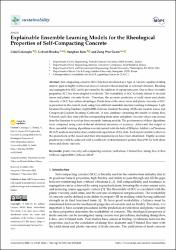Explainable ensemble learning models for the rheological properties of self-compacting concrete
Citation
Çakıroğlu, C., Bekdaş, G., Kim, S., & Geem, Z. W. (2022). Explainable Ensemble Learning Models for the Rheological Properties of Self-Compacting Concrete. Sustainability, 14(21), 14640.Abstract
Self-compacting concrete (SCC) has been developed as a type of concrete capable of filling narrow gaps in highly reinforced areas of a mold without internal or external vibration. Bleeding and segregation in SCC can be prevented by the addition of superplasticizers. Due to these favorable properties, SCC has been adopted worldwide. The workability of SCC is closely related to its yield stress and plastic viscosity levels. Therefore, the accurate prediction of yield stress and plastic viscosity of SCC has certain advantages. Predictions of the shear stress and plastic viscosity of SCC is presented in the current study using four different ensemble machine learning techniques: Light Gradient Boosting Machine (LightGBM), Extreme Gradient Boosting (XGBoost), random forest, and Categorical Gradient Boosting (CatBoost). A new database containing the results of slump flow, V-funnel, and L-Box tests with the corresponding shear stress and plastic viscosity values was curated from the literature to develop these ensemble learning models. The performances of these algorithms were compared using state-of-the-art statistical measures of accuracy. Afterward, the output of these ensemble learning algorithms was interpreted with the help of SHapley Additive exPlanations (SHAP) analysis and individual conditional expectation (ICE) plots. Each input variable's effect on the predictions of the model and their interdependencies have been illustrated. Highly accurate predictions could be achieved with a coefficient of determination greater than 0.96 for both shear stress and plastic viscosity.

















